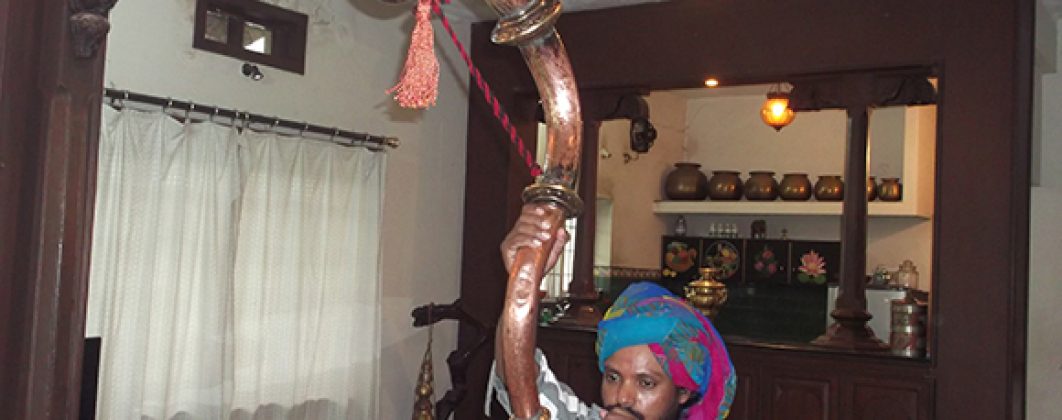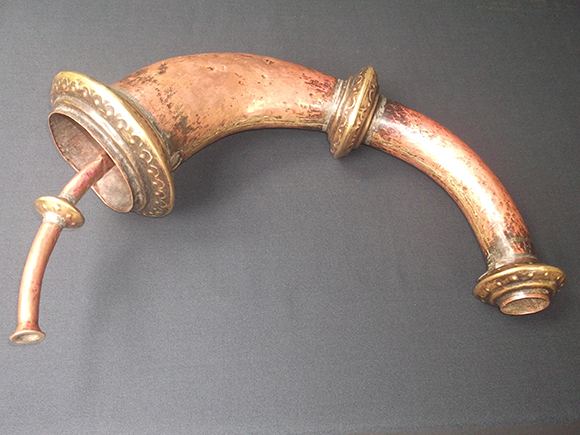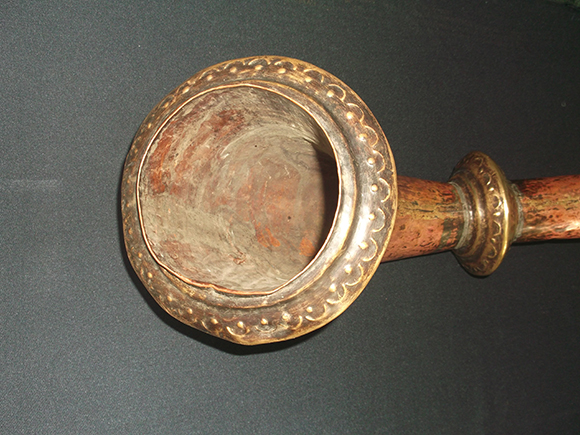

The trumpet shown in the picture is known as Narsingha or Ransingha trumpet and is mostly used in Nepal, Himachal Pradesh, Rajasthan, and Kullu Manali in the Himalayan ranges. This curved “S” shaped trumpet is hand made out of copper and brass combination. The main trumpet is made with copper and the trims and embellishments are of Brass. It is used like a bugle.


Description of the Trumpet
The Indian Ransingha trumpet is a royal and vintage instrument. The curved trumpet is made in two sections. The wider section is called Dhaturo and the thinner section is called Dhopbana. When joined together, they form a majestic “S” shaped trumpet. There are hooks on the wider section at both the ends and when tied with a rope, it forms a bow shape. When the trumpet is not in use, the thinner section is inserted into the wider section and is hung on the nail with the rope. When it is being carried, the rope is hung on the shoulder and the arched section is rested on the back of the shoulder for comfort and convenience. At the time of blowing, these two sections are joined together.

The stretched out length of the “S” shaped trumpet is 60 inches and its height is 42 inches. The shape of the trumpet and the wind pipe is telescopic. It starts with a small size mouthpiece with 1 inch diameter and arches out and ends with wide opening of 5.3 inches diameter. The actual diameter of the blow hole is 0.2 inches.


There are 5 brass trims in the shape of rings on the trumpet body and these trims are hollow inside and are filled with mini metal balls that produce musical sound when the trumpet is jingled or position is changed. There is a beautiful design on all the five trims and the design is very elaborate on the 5th and the biggest trim at the end.





The History of Trumpet
In ancient times, buffalo horn was used as a trumpet. The Indian horn is made from the horn of buffalo and is called as Shinga or Srnga in Sanskrit. Later, the term Shringa was used to denote any horn or trumpet. In the southern part of India, the horn is called Kombu. The horn has evolved into the present day’s version Narsingha over a period of time which is called Turya in Sanskrit. Subsequently, this came to be known as Turahi and also Narsingha. The name Narsingha literally means “Buffalo horn”. The buffalo horn is long and conical in shape. The primitive artisans drilled a conical bore through the horn and used to blow it as a natural trumpet. Subsequently, the artisans like Tinsmiths, coppersmiths, and blacksmiths imitated the natural horn trumpet and created trumpets with copper and brass metals. They made trumpets in “C” shape and “S” shape also. The shape of the trumpet will not drastically affect the tonal quality of the sound.

Tradition of Trumpet Usage
Narsingha is played in auspicious occasions like marriages. It is the leading instrument when the marriage procession is marching towards the bride’s house. On the way, if they cross holy places, temples, rivulets and rivers, the Narsingha is played. The efficient Narasingha player can produce sounds of calling names, scolding, and alerting another marriage party to give them the right of passage in the narrow road crossings. It is also used in ceremonial religious processions of village deities. The belief is that the loud harsh sound that emerges from the trumpet will chase away evil spirits and thus give way to holy events. While waging war or after a victory, Narsingha was blown to scare the enemies.


In Naumati Baaja (nine instruments orchestra), a traditional Nepali band procession, the Narsinghas are always the leading trumpets. In a traditional procession, there will be two Narsinghas playing alternatively. The prestige of the procession host depends on the number of Narsinghas he has deployed.
The sound produced by a well-made Narsingha trumpet can be heard up to 15 kilometres. There is tradition that the gun is fired after the trumpet is blown. This custom reveals the relationship that the Narasingha trumpet has with wars.
In Rajasthan, the Ransingha trumpet is used to welcome the guests and dignitaries into the palaces and Havelis and it is also the leading traditional instrument for Baraat or the marriage procession.
The Technique of Trumpet Playing
Those who play the trumpet use circular breathing technique as the Shahanai player does, and different notes are achieved by rapid tongue movements. Also, flutter tonguing is articulated to modulate the sound. It is the technique that matters to produce the required sound and not the power of the blow.
My First Experience with a Horn Trumpet
My maternal grandfather’s village Korumilly in Andhra Pradesh, India is surrounded by river Godavari and the canals of Godavari waters. My grandfather’s name is Shri. Salapaka Linga Murthy. There were no motor-able roads to reach the village back then. When I was a young boy, we used to go on a canal boat. Even the merchandise for sale in the village came by boats. Whenever the villagers heard a trumpet sound from a horn, they used to rush to the canal. This was the sound blown by the merchants to announce that the boat had come and was parked in the canal to sell its merchandise. This was my first introduction to a trumpet horn sound.

I purchased this beautiful “S” shaped Ransingha trumpet from an antique dealer in Delhi. He told me that he acquired this gem from Kullu Manali valley of Himalayas range.

Copyright © 2021 YK Antiques Home Museum
6 Responses
This post will certainly win all the hearts of Antique thing lovers. You showed a great skill in taking each photograph of Ransingha Trumpet.. I felt the uniqueness in the above post.This is really an extraordinary post to anybody to add this as a bookmark or social Share.i loved it and thanks a lot for the heart stealing post above..
Sir do you have ransingha for sale
Hello Raj Singh ji,
I have only one ransingha and it is exhibited in our home Museum. It is meant for exhibition and not for sale.